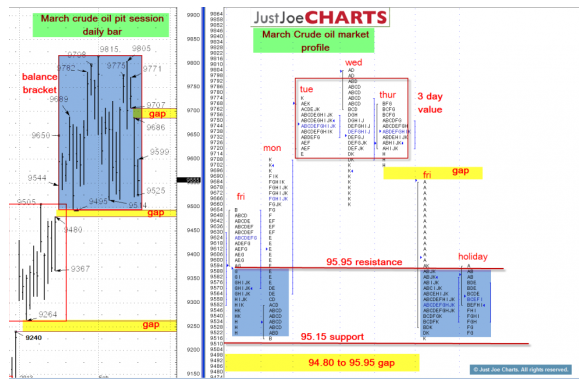March crude oil futures have been a relatively tight $94.95 to $98.15 balance bracket for over the past month.
After trading near the $98.15 balance bracket high for three days last week, the market broke down on Friday and came within 30 ticks of the $94.95 balance bracket low. Additionally, during the Monday holiday yesterday , the market found balance in between a $95.15 support level and a $95.95 resistance level.
The term "GO/NO GO LEVEL" was coined by my mentor, Jim Dalton. Jim uses that term when a market reaches an important reference where the odds of a significant move, in either direction, are high. In this case, the lower extreme of the balance bracket is the GO/NO GO level.
When the market tests an extreme of a balance bracket, the 2 most likely scenarios are: 1) gain acceptance outside the balance bracket and accelerate or 2) trade outside the balance bracket and get rejected, which would likely begin a rotation to the opposite end of the balance bracket. An example of a GO/NO GO level was this past Wednesday, when the high of $98.05 came within 10 ticks of $98.15 balance bracket high. After a tight balance day on Thursday, the market broke down on Friday and came within 30 ticks of the balance bracket low. The failures at one extreme of balance lead to a quick rotation to the opposite end of that balance.
During four of the last seven trading days, the market has found support near $95.15. Additionally, below the $94.95 balance bracket low, there is a $94.80 to $94.95 gap. If the market trades below the $95.15 support level, it may test the $94.95 balance bracket low and that gap. If the market gains acceptance below the gap and breaks from balance to the downside, it may test the $93.67 reference, and evidentially test another gap below of $92.40 to $92.64.
The market has found resistance at $95.95 several times during the last seven trading days. If the market gains acceptance above the $95.95 resistance level, it may test the $96.86 to $97.07 gap above.
- English (UK)
- English (India)
- English (Canada)
- English (Australia)
- English (South Africa)
- English (Philippines)
- English (Nigeria)
- Deutsch
- Español (España)
- Español (México)
- Français
- Italiano
- Nederlands
- Português (Portugal)
- Polski
- Português (Brasil)
- Русский
- Türkçe
- العربية
- Ελληνικά
- Svenska
- Suomi
- עברית
- 日本語
- 한국어
- 简体中文
- 繁體中文
- Bahasa Indonesia
- Bahasa Melayu
- ไทย
- Tiếng Việt
- हिंदी
US Crude Oil At A Crossover: Support At $95.15 Levels
Published 02/20/2013, 04:46 AM
Updated 05/14/2017, 06:45 AM
US Crude Oil At A Crossover: Support At $95.15 Levels
Latest comments
Loading next article…
Install Our App
Risk Disclosure: Trading in financial instruments and/or cryptocurrencies involves high risks including the risk of losing some, or all, of your investment amount, and may not be suitable for all investors. Prices of cryptocurrencies are extremely volatile and may be affected by external factors such as financial, regulatory or political events. Trading on margin increases the financial risks.
Before deciding to trade in financial instrument or cryptocurrencies you should be fully informed of the risks and costs associated with trading the financial markets, carefully consider your investment objectives, level of experience, and risk appetite, and seek professional advice where needed.
Fusion Media would like to remind you that the data contained in this website is not necessarily real-time nor accurate. The data and prices on the website are not necessarily provided by any market or exchange, but may be provided by market makers, and so prices may not be accurate and may differ from the actual price at any given market, meaning prices are indicative and not appropriate for trading purposes. Fusion Media and any provider of the data contained in this website will not accept liability for any loss or damage as a result of your trading, or your reliance on the information contained within this website.
It is prohibited to use, store, reproduce, display, modify, transmit or distribute the data contained in this website without the explicit prior written permission of Fusion Media and/or the data provider. All intellectual property rights are reserved by the providers and/or the exchange providing the data contained in this website.
Fusion Media may be compensated by the advertisers that appear on the website, based on your interaction with the advertisements or advertisers.
Before deciding to trade in financial instrument or cryptocurrencies you should be fully informed of the risks and costs associated with trading the financial markets, carefully consider your investment objectives, level of experience, and risk appetite, and seek professional advice where needed.
Fusion Media would like to remind you that the data contained in this website is not necessarily real-time nor accurate. The data and prices on the website are not necessarily provided by any market or exchange, but may be provided by market makers, and so prices may not be accurate and may differ from the actual price at any given market, meaning prices are indicative and not appropriate for trading purposes. Fusion Media and any provider of the data contained in this website will not accept liability for any loss or damage as a result of your trading, or your reliance on the information contained within this website.
It is prohibited to use, store, reproduce, display, modify, transmit or distribute the data contained in this website without the explicit prior written permission of Fusion Media and/or the data provider. All intellectual property rights are reserved by the providers and/or the exchange providing the data contained in this website.
Fusion Media may be compensated by the advertisers that appear on the website, based on your interaction with the advertisements or advertisers.
© 2007-2025 - Fusion Media Limited. All Rights Reserved.
